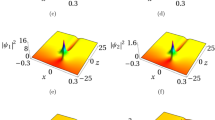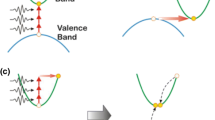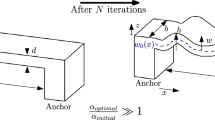Abstract
To realize large scanning angles, torsional microscanners are normally excited at their natural frequencies. Usually, a bias DC voltage is also applied to scan around a desired nonzero tilt angle. As a result, a deep understanding of the mirror’s response to a DC-shifted primary resonance excitation is imperative. Along these lines, we use the method of multiple scales to obtain a second-order nonlinear approximate analytical solution of the mirror steady-state response. We show that the response of the mirror exhibits a softening-type behavior that increases as the magnitude of the DC component increases. For a given mirror, we can also identify a DC voltage range wherein the mirror exhibits a two-to-one internal resonance between the first two modes; that is, ω 2≈2ω 1. To analyze the mirror behavior within that range, we first treat the case where the excitation frequency is near the first-mode frequency; that is, Ω≈ω 1. Then we treat the case where the excitation frequency is near the second-mode frequency; that is, Ω≈ω 2. We analyze the stability of the response and compare the analytical results to numerical solutions obtained via long-time integration of the equations of motion. We show that, due to the internal resonance, the mirror exhibits complex dynamic behavior characterized by aperiodic responses to primary resonance excitations. This behavior results in undesirable oscillations that are detrimental to the mirror performance, namely bringing the target point in and out of focus and resulting in distorted images.
Similar content being viewed by others
References
Van Kessel, P.F., Hornbeck, L.J., Meier, R.E., Douglass, M.R.: MEMS-based projection display. Proc. IEEE 86(8), 1687–1704 (1998)
Ford, J.E., Aksyuk, V.A., Bishop, D.J., Walker, J.A.: Wavelength add-drop switching using tilting micromirrors. J. Lightwave Technol. 17(5), 904–911 (1999)
Lin, L.Y., Goldstein, A.L., Tkach, R.W.: Free-space micromachined optical switches for optical networking. IEEE J. Sel. Top. Quantum Electron. 5(1) (1999)
Collins, D.R., Sampsell, J.B., Hornbeck, L.J., Florence, P.A., Penz, P.A., Gately, M.T.: Application of improved deformable mirror array technology to neural network realization. Neural Netw. 1(1), 378–382 (1988)
Cohn, R.W., Sampsell, J.B.: Deformable mirror device uses in frequency excision and optical switching. Appl. Opt. 27, 937–940 (1988)
Hornbeck, L.J.: 128 multiplied by 128 deformable mirror device. IEEE Trans. Electron Dev. 30(5), 539–545 (1983)
Fan, L., Yu, M.C.: Two-dimensional optical scanners with large angular rotation realized by self-assembled micro-elevator. In: Proceedings of the IEEE LEOS Summer Topical Meeting on Optical MEMS, Monterey, CA pp. 107–108 (1998)
Osterberg, P.M.: Electrostatically actuated microelectromechanical test structures for material property measurements. PhD thesis, MIT, Cambridge, MA (1995)
Hornbeck, L.J.: Deformable-mirror spatial light modulators. SPIE Crit. Rev. Ser. 1150, 86–102 (1989)
Degani, O.B., Socher, E., Lipson, A., Leitner, T., Setter, D.J., Kaldor, S., Nemirovisky, Y.: Pull-in study of an electrostatic torsion microactuator. J. Microelectromech. Syst. 7(4), 373–379 (1998)
Nemirovisky, Y., Degani, O.B.: A methodology and model for the pull-in parameters of electrostatic actuators. J. Microelectromech. Syst. 10(4), 601–614 (2001)
Degani, O.B., Nemirovisky, Y.: Design considerations of rectangular electrostatic torsion actuators based on new analytical pull-in expressions. J. Microelectromech. Syst. 11(1), 20–26 (2002)
Zhang, X.M., Chau, F.S., Quan, C., Liu, A.Q.: Modeling of the optical torsion micromirror. In: Proceedings of the SPIE Conference on Photonics Technology in the 21st Century: Semiconductors, Microstructures, and Nanostructures, Singapore, pp. 109–116 (1999)
Zhang, X.M., Chau, F.S., Quan, C., Lam, Y.L., Liu, A.Q.: Study of the static characteristics of a torsional micromirror. J. Microelectromech. Syst. 90, 73–81 (2001)
Degani, O.B., Nemirovisky, Y.: Modeling the pull-in parameters of electrostatic actuators with a novel lumped two degrees of freedom pull-in model. Sens. Actuators A 97–98, 569–578 (2002)
Huang, J.M., Liu, A.Q., Deng, Z.L., Zhang, Q.X., Ahn, J., Asundi, A.: An approach to the coupling effect between torsion and bending for electrostatic torsional micromirrors. Sens. Actuators A 115, 159–167 (2004)
Wetzel, G.C., Strozewski, K.J.: Dynamical model of microscale electromechanical spatial light modulator. J. Appl. Phys. 73(11), 7120–7124 (1993)
Sattler, R., Florian, P., Fattinger, G., Wachutka, G.: Modeling of an electrostatic torsional actuator: Demonstrated with an RF MEMS switch. Sens. Actuators A 97, 337–346 (2002)
Sane, H.S., Yazdi, N., Carlos, H.M.: Application of sliding mode control to electrostatically actuated two-axis gimbaled micromirrors. In: Proceedings of the American Control Conference, Denver, CO, pp. 3726–3731 (2003)
Ataman, C., Urey, H.: Modeling and characterization of comb-actuated microscanners. J. Micromech. Microeng. 16, 9–16 (2006)
Camon, H., Lanaudi, F.: Fabrication, simulation, and experiment of a rotating electrostatic silicon mirror with large angular deflections. In: Proceedings of the IEEE Micro Electro Mechanical Systems (MEMS), Japan, pp. 645–650 (2000)
Zhao, J.P., Chen, H.L., Huang, J.M., Liu, A.Q.: A study of dynamic characteristics and simulations of MEMS torsional micromirror. Sens. Actuators A 120, 199–210 (2005)
Daqaq, M.F.: Adaptation of nontraditional control techniques to nonlinear micro and macro mechanical systems. PhD thesis, Virginia Tech, Blacksburg, VA (2006)
Timoshenko, S.: Theory of Plates and Shells. McGraw-Hill, New York (1987)
Nayfeh, A.H.: Introduction to Perturbation Techniques. Wiley-Interscience, New York (1981)
Daqaq, M.F., Abdel-Rahman, E.M., Nayfeh, A.H.: Towards a stable low-voltage torsional microscanner. Microsyst. Technol. 14, 725–737 (2008)
Nayfeh, A.H.: Resolving controversies in the application of the method of multiple scales and the generalized method of averaging. Nonlinear Dyn. 40, 61–102 (2005)
Arafat, H.N.: Nonlinear response of cantilever beams. PhD thesis, Virginia Tech, Blacksburg, VA (1999)
Author information
Authors and Affiliations
Corresponding author
Rights and permissions
About this article
Cite this article
Daqaq, M.F., Abdel-Rahman, E.M. & Nayfeh, A.H. Two-to-one internal resonance in microscanners. Nonlinear Dyn 57, 231–251 (2009). https://doi.org/10.1007/s11071-008-9435-2
Received:
Accepted:
Published:
Issue Date:
DOI: https://doi.org/10.1007/s11071-008-9435-2




